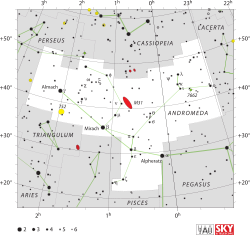| Observation data Epoch J2000 Equinox J2000 | |
|---|---|
| Constellation | Andromeda |
| Right ascension | 23h 04m 10.98269s[1] |
| Declination | +50° 03′ 07.5255″[1] |
| Apparent magnitude (V) | 4.64[2] |
| Characteristics | |
| Evolutionary stage | giant[3] |
| Spectral type | K0 IIIb[4] |
| B−V color index | 1.058±0.003[2] |
| Astrometry | |
| Radial velocity (Rv) | −34.87±0.12[1] km/s |
| Proper motion (μ) | RA: 165.837[1] mas/yr[1] Dec.: 167.716 mas/yr[1] |
| Parallax (π) | 17.2629 ± 0.0918 mas[1] |
| Distance | 189 ± 1 ly (57.9 ± 0.3 pc) |
| Absolute magnitude (MV) | 0.97[2] |
| Details | |
| Mass | 1.71[5] M☉ |
| Radius | 10[6] R☉ |
| Luminosity | 49[5] L☉ |
| Surface gravity (log g) | 2.61±0.11[7] cgs |
| Temperature | 4,668±45[5] K |
| Metallicity [Fe/H] | −0.08[3] dex |
| Rotational velocity (v sin i) | 1.0[8] km/s |
| Age | 2.27[5] Gyr |
| Other designations | |
| Database references | |
| SIMBAD | data |
3 Andromedae, abbreviated 3 And, is a single[10] star in the northern constellation of Andromeda. 3 Andromedae is the Flamsteed designation. It is visible to the naked eye with an apparent visual magnitude of 4.64.[2] The distance to this star, as determined from an annual parallax shift of 17.3 mas,[1] is 181 light years. It is moving closer to the Earth with a heliocentric radial velocity of −35 km/s,[11] and has a relatively large proper motion, traversing the celestial sphere at 0.236″·yr−1.[12]
This is an evolved giant star with a stellar classification of K0 IIIb,[4] where the 'b' suffix indicated a lower luminosity giant. It is a red clump star,[3] which means it is generating energy through helium fusion at its core. This star has an estimated 1.7[5] times the mass of the Sun (M☉), and, at the age of 2.3[5] billion years, has expanded to 10 times the Sun's radius (R☉).[6] It is radiating 49[5] times the Sun's luminosity from its enlarged photosphere at an effective temperature of 4,668 K.[5]
- ^ a b c d e f g Vallenari, A.; et al. (Gaia collaboration) (2023). "Gaia Data Release 3. Summary of the content and survey properties". Astronomy and Astrophysics. 674: A1. arXiv:2208.00211. Bibcode:2023A&A...674A...1G. doi:10.1051/0004-6361/202243940. S2CID 244398875. Gaia DR3 record for this source at VizieR.
- ^ a b c d Cite error: The named reference
Anderson2012was invoked but never defined (see the help page). - ^ a b c Cite error: The named reference
Tautvaisiene2010was invoked but never defined (see the help page). - ^ a b Cite error: The named reference
perkins1989was invoked but never defined (see the help page). - ^ a b c d e f g h Cite error: The named reference
Luck2015was invoked but never defined (see the help page). - ^ a b Cite error: The named reference
Massarotti2008was invoked but never defined (see the help page). - ^ Cite error: The named reference
Feuillet2016was invoked but never defined (see the help page). - ^ Cite error: The named reference
DeMedeiros2000was invoked but never defined (see the help page). - ^ Cite error: The named reference
SIMBADwas invoked but never defined (see the help page). - ^ Cite error: The named reference
Eggleton2008was invoked but never defined (see the help page). - ^ Cite error: The named reference
Gontcharov2006was invoked but never defined (see the help page). - ^ Cite error: The named reference
Lepine2005was invoked but never defined (see the help page).
